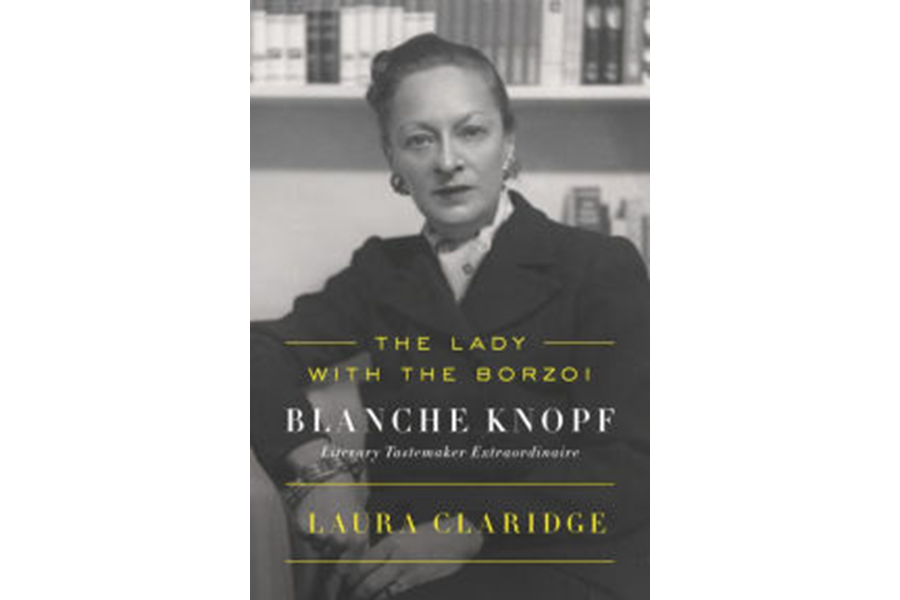'The Lady with the Borzoi' profiles publishing legend Blanche Knopf
Loading...
Alfred and Blanche Knopf did not have a marriage made in heaven. On good authority – that is, anyone ever known to have been asked by anybody – it was a 100-car train wreck. Laura Claridge’s The Lady with the Borzoi joins the chorus: He was heavy weather, she was – despite stabs at tenderness – willing to take the open route. Even their son fled the scene as soon as he could. The only good that ever came from the Knopfs was Knopf.
Alfred and Blanche didn’t even like the same books, but their small publishing house, cofounded in 1915, had a bloodhound’s nose for the zeitgeist to come. “Blanche, two years younger, believed her future as a publisher guaranteed through a prenuptial verbal pact she made with Alfred that they would be equal partners.”
Blanche, evidently, was not a good judge of character. Partner? She never even made it onto the company masthead. Alfred, evidently, had no character at all, unless a viciously swelled head qualifies. But “Lady” is about Blanche.
Claridge (a well-regarded biographer whose other subjects include Emily Post and Norman Rockwell) wants to rub some of that Knopf radiance off on Blanche. And Blanche did spend much time in the limelight during her days as a literary headhunter. She was a jet-setter when there were only propellers, seeking culture: high or unconventional, as long as it had the stuff.
It took salesmanship: Knopf’s pockets were never as deep as its literary instinct. Blanche worked like a dog – a stylishly dressed, artfully spoken dog who was also an astute listener with a taste for bourbon and caviar – to sign vanguard talent: Dashiell Hammett, Raymond Chandler, Nella Larsen, James Baldwin, Langston Hughes, Willa Cather, Muriel Spark, Wallace Stevens, Henry Mencken, William Shirer, John Hersey, Thomas Mann, Sigmund Freud, Albert Camus, Simon de Beauvoir, and Jorge Amado.
Once she did sign them, of course, Alfred took the credit. Claridge handles the theme of a woman’s struggle for power and recognition with aplomb.
It is difficult for Claridge’s story to gather momentum as the Knopfs never sat still. Alfred headed west, after the literature and life of history and adventure.
Blanche headed south, but mostly east, to French philosophy, green faille, salons, the bite of Muriel Spark, the precocity of Simone de Beauvoir, always with an eye skinned for work that pushed boundaries – race, war, radical politics. The best of these books, Blanche understood, were not only important, but necessary. It is no easy matter to glean Blanche’s sensibility from her letters, which can reek with pampered mewling, or from the comments made by others – the exceptions being Mencken and Carl Van Vechten – but Claridge draws out Blanche’s audaciousness in composing a list of titles that still stands on high ground.
Claridge also does well in delineating Blanche’s role in furthering Modernism; embracing the New Negro Movement, which morphed into the Harlem Renaissance; nursing her authors along (an exquisitely touchy mob, to get them to write at all may have been Blanche’s greatest accomplishment); encouraging preludes to New Journalism.
The incessant Blanche/Alfred shoving match – the “couple’s peace was always frangible,” writes Claridge, sounding a new depth in understatement – soon wears thin. Okay, Alfred was not a nice guy and Blanche could give as good as she got, but the fiasco doesn’t quicken the Knopf story. Sometimes it adds confusion. Their son Pat remembers “Alfred beat her from the beginning.”
Claridge reins that in: “Given Pat’s complicated personality,” – he shared, perhaps, the same Freudian “reaction formation” toward authority as Alfred – “it is hard to know what to trust.” Yet, without additional confirmation, Claridge tenders shortly thereafter that “Blanche surely felt the shame of the battered wife, the sense that she had done something wrong.”
There are other bafflements: Blanche travels to South America, “on a cruise ship that would naturally provide her with a bed.” Or, what, not? Then consider: “There was never a better time than the 1920s to be all over the sexual map.” From Zelda and Scott Fitzgerald to Alfred and Blanche, such experimentation did not lead to much happiness.
These are smart notes toward understanding Blanche Knopf. Blanche was a force for good: building a brilliant catalogue, continuing to work for years even as her eyesight failed. She had her faults and her husband even more. But in the end the achievements of the Knopfs were remarkable and readers today owe much to their legacy – and to Blanche in particular.
Peter Lewis reviews books regularly for the Monitor.








